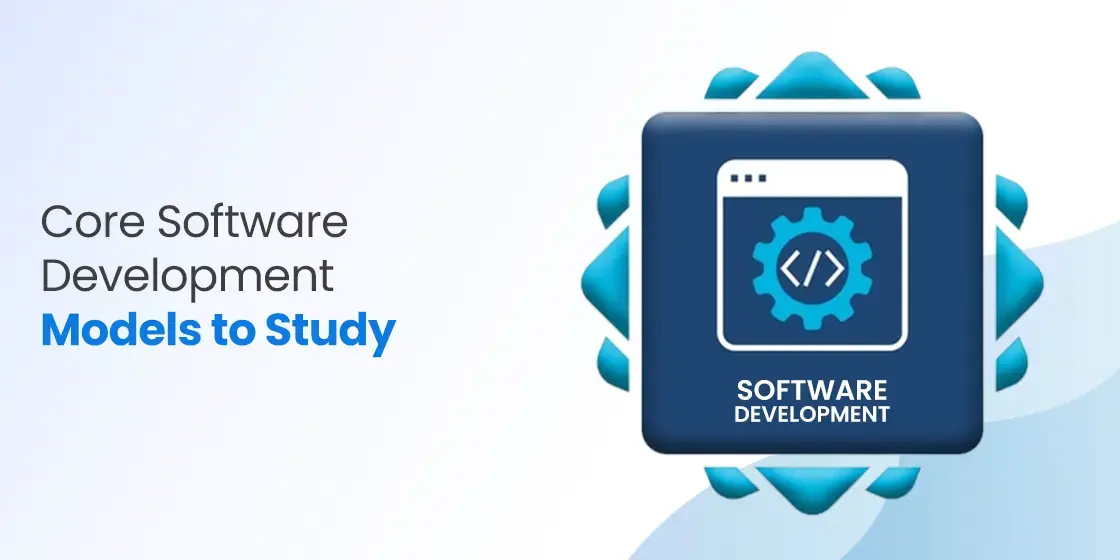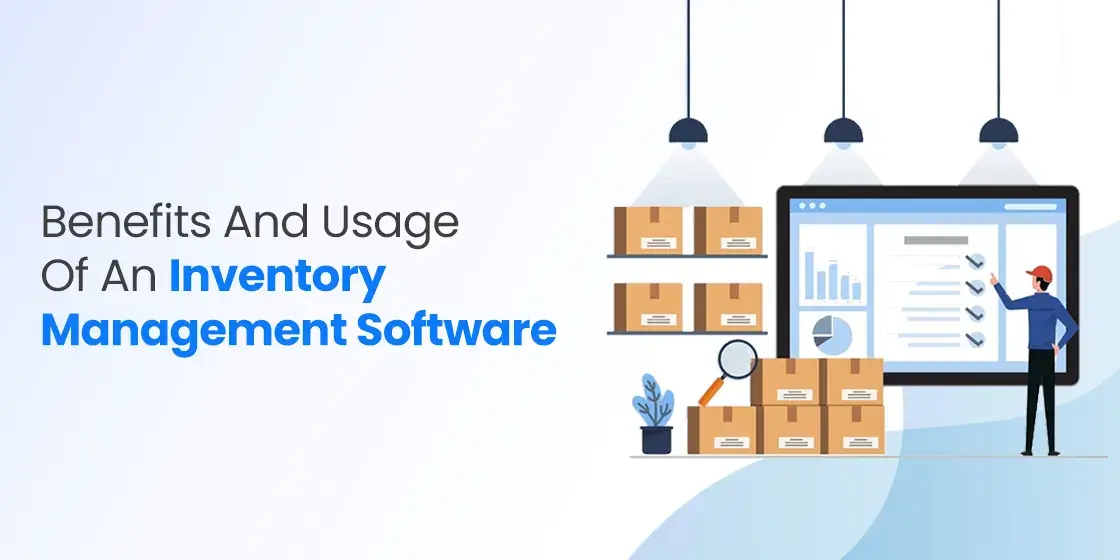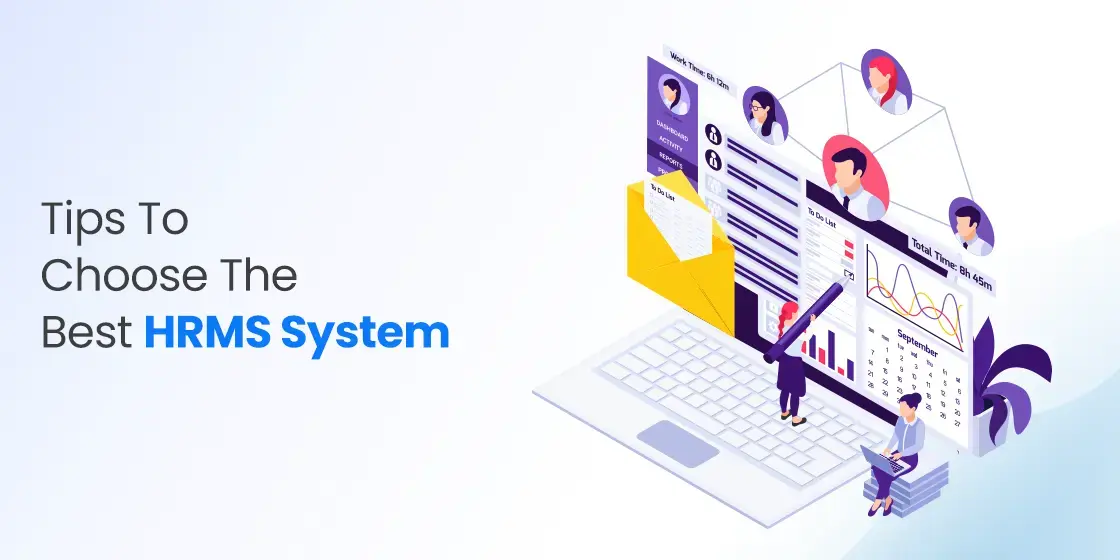Table of Content
Know the Utility of Every Software Development Model in Detail
Software development has become a highly lucrative field in the tech world. The jobs in this sector are increasing day by day, because software development has become a big demand for many businesses. Seeing this upward trend, many people are aspiring to build their careers in it to offer their own software development services. These people should need to first understand the basics of software development. They need to learn different software development models that are used to build a variety of applications. This is an essential part of learning, because every project is developed by following a model.
Being a beginner, you need to understand what is a Software Development Lifecycle (SDLC) process. This is important because all the models comes from the umbrella of SDLC. If you understand the hierarchy and phases of SDLC, then planning and executing different tasks won’t remain a problem for you. Unfortunately, it is one of those areas where many beginners don’t pay attention to. They do not understand the software lifecycle process, as how does it work and what type of phases are included in it.
This blog is precisely written to let you understand how the SDLC works. It will explore different software development models that are used in this lifecycle process. It is therefore a good read for beginners who’ve just started learning software development. Let’s start from the basics understanding what is SDLC and why understanding it completely is important for developers.
Understanding Software Development Lifecycle (SDLC)

The Software Development Lifecycle (SDLC) is a structured process used by software developers to design, develop, test, and deploy software applications. It provides a systematic approach to software development, ensuring that all aspects of the project are considered and executed efficiently. The SDLC typically includes several key phases: planning, analysis, design, implementation, testing, deployment, and maintenance. Each phase serves a specific purpose and contributes to the overall success of the software project.
During the planning phase, project goals and requirements are defined, helping to establish a clear roadmap for development. This is followed by the analysis phase, where detailed requirements are gathered, and feasibility studies may be conducted. The design phase involves creating architectural specifications and user interface designs, providing a blueprint for developers. In the implementation phase, the actual coding takes place, and the software is built according to the established design. This is typically followed by the testing phase, where the software is rigorously evaluated for defects.
Once testing is complete, the software moves into the deployment phase, where it is released to users. After deployment, the maintenance phase begins, which involves regular updates, bug fixes, and enhancements based on user feedback. The SDLC is crucial for managing the complexities of software development, improving project visibility, and ensuring that the final product is reliable, efficient, and meets user needs. By adhering to the SDLC, organizations can minimize risks, control costs, and deliver high-quality software solutions.
Partner with our software development specialists to pioneer custom solutions that drive your business forward.
Request Your Solution
Key Software Development Models to Know About
Starting as a beginner, you need to lay a strong foundation understanding the different phases of development. This will lead you to understand various software development models that are used by the professionals to build CRM software and other enterprise solutions. If you do not know much about them, here’s a brief explanation discussing all the key models of software development.
Waterfall Model
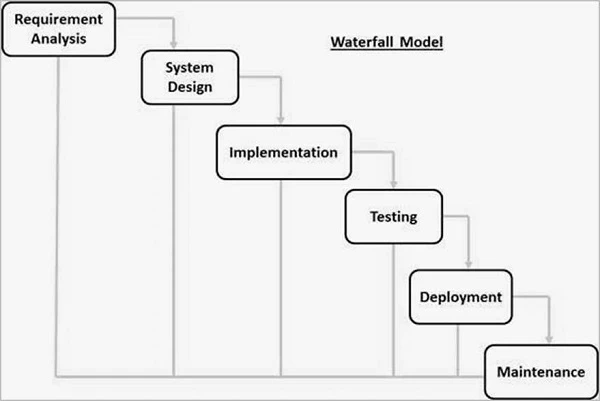
The waterfall model is a fundamental software development life cycle (SDLC) approach that serves as an essential framework for beginners entering the field of software development. This methodology is structured to guide new developers through the complexities of software creation by breaking down the entire process into distinct, manageable phases. Each phase serves a specific purpose and builds upon the previous one, creating a clear pathway from conception to completion.
In the waterfall model, the software development process is visualized as a linear progression that flows steadily downward. This model delineates each stage, starting with requirements analysis, where developers gather and clarify what the software needs to achieve. Following this is the design phase, where architects create blueprints for the software’s architecture and user interface. Implementation then occurs, involving actual coding and construction of the software, leading into the critical testing phase, where the product is validated against the original requirements.
Once the software has been thoroughly tested and any necessary adjustments made, it moves into the integration and maintenance phases. Integration involves combining different software components into a unified whole, ensuring they function together seamlessly. Finally, the maintenance phase addresses ongoing support and updates, which are crucial for adapting the software to evolving user needs. Overall, the waterfall model provides a structured approach that can greatly benefit those new to software development by emphasizing clarity throughout the entire process.
Advantages of Waterfall Model
- The waterfall model features well-defined phases. This structured approach helps ensure that each aspect of the development process is addressed systematically.
- With its linear progression, the waterfall model simplifies project management. Each phase has specific deliverables and timelines, making it easier for project managers to track progress.
- The model emphasizes comprehensive documentation at every stage, which serves as a valuable resource for future reference. This documentation provides clarity for all stakeholders and can be particularly beneficial for onboarding new team.
- Since the waterfall model follows a sequential approach, it allows for accurate estimation of project timelines and costs.
- The waterfall model is particularly effective for projects with clear and stable requirements. In situations where changes are minimal, this model can lead to efficient development and a high-quality final product.
RAD Model
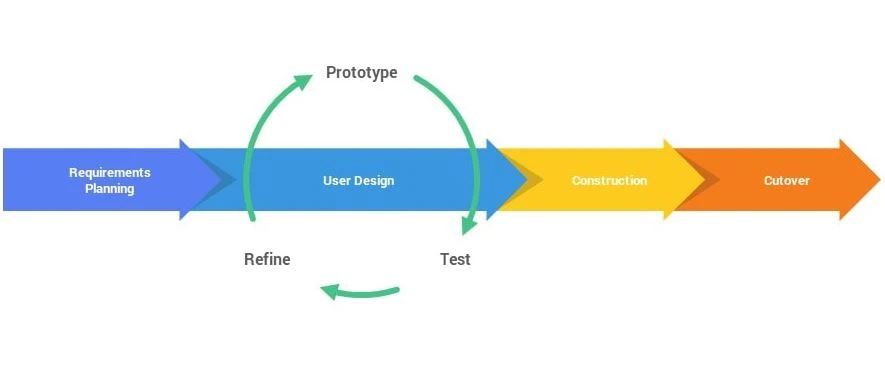
The Rapid Application Development (RAD) process is an innovative approach that builds upon the traditional waterfall model of software development. Unlike the linear progression of the waterfall model, RAD emphasizes speed and flexibility, aiming to create web apps in a significantly shorter timeframe. This methodology is particularly suited for projects where quick delivery and iterative development are crucial, allowing teams to respond swiftly to changing requirements and user feedback.
At the core of the RAD model is the belief that engaging with focus groups can enhance the software development process. By actively involving stakeholders and potential users from the outset, developers can gather valuable insights and system requirements that inform the project’s direction. This collaborative approach not only ensures that the final product better meets user needs but also fosters a sense of ownership among participants, which can lead to improved satisfaction and adoption of the software.
Ultimately, the RAD process prioritizes rapid prototyping and continuous iteration over exhaustive documentation and planning. By breaking the development cycle into manageable increments, teams can quickly test and refine their ideas based on real-time feedback. This iterative cycle not only accelerates the development process but also encourages innovation, as developers can experiment with different solutions and make adjustments based on user interactions, resulting in a more effective and user-friendly final product.
Advantages of RAD Model
- RAD significantly reduces the development timeline by emphasizing quick iterations and rapid prototyping. This allows organizations to deliver functional software to users more quickly.
- By incorporating feedback from focus groups and end-users throughout the development process, RAD ensures that the final product aligns closely with user needs and expectations.
- The iterative nature of RAD allows for continuous adjustments based on feedback and changing requirements. This flexibility helps teams respond promptly to new insights or shifts in project direction.
- Frequent prototyping and testing help identify potential issues early in the development process. By addressing problems as they arise, teams can mitigate risks and avoid costly changes later in the project.
- Continuous user feedback during development helps ensure that usability and functionality are prioritized. This iterative refinement process often leads to a higher quality product.
V-Model
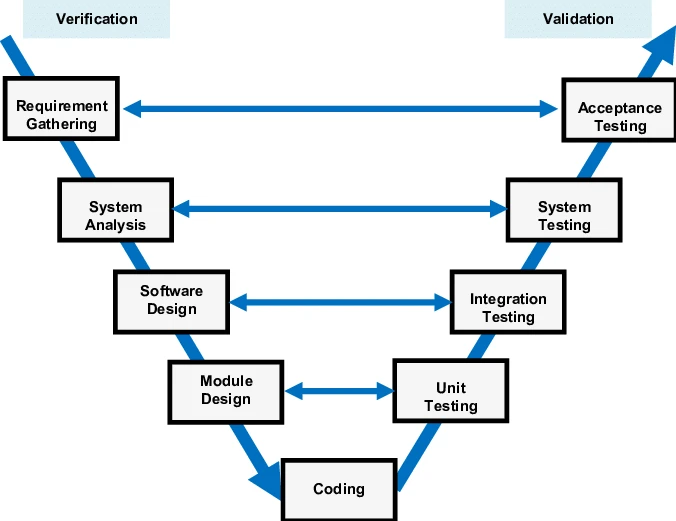
The V-Model is a structured approach commonly utilized in the software development lifecycle, renowned for its disciplined methodology. This model visualizes the development process in a “V” shape, illustrating the stages of development on one side and corresponding testing phases on the other. By aligning each development phase with its respective testing activities, the V-Model emphasizes the importance of validation and verification throughout the project, ensuring that quality is maintained at every step.
In the V-Model, the execution of processes follows a strict sequential order. Each phase must be completed before the next one can commence, creating a clear and organized progression through the development lifecycle. This linear approach allows for comprehensive planning and documentation at each stage, which is essential for maintaining clarity and accountability. It also facilitates better resource allocation and timeline management, as teams can anticipate the requirements and outcomes of each phase before moving forward.
One of the key benefits of the V-Model is its focus on early detection of defects. By integrating testing activities directly into the development phases, issues can be identified and addressed promptly, reducing the likelihood of significant problems arising later in the process. This proactive stance not only enhances the overall quality of the final product but also fosters greater confidence among stakeholders, as they can see the rigorous testing and validation processes that accompany the development effort.
Advantages of V-Model
- The V-Model provides a well-defined, structured approach to software development, which helps teams understand each phase’s specific objectives and deliverables.
- By integrating testing phases alongside development activities, the V-Model allows for early identification of defects and issues.
- The sequential nature of the V-Model encourages collaboration among team members. Regular checkpoints and testing phases foster communication, ensuring that everyone remains aligned.
- The V-Model emphasizes thorough documentation at each stage, which serves as a valuable reference throughout the project.
- The focus on validation and verification at every stage instills greater confidence in the final product. Stakeholders can be assured that the software has undergone rigorous testing and meets the established requirements.
Iterative Model
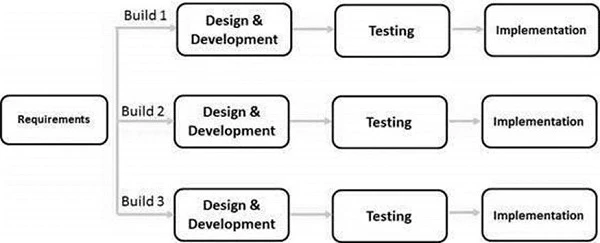
The Iterative model, similar to various other software development frameworks, was created to address and overcome some of the limitations associated with the Waterfall model. While the Waterfall model follows a linear and sequential approach, the Iterative model introduces a more dynamic process. It begins with initial planning and progresses through various stages of development, ultimately leading to deployment. This structured approach allows for a clearer roadmap but is enhanced by its flexibility in revisiting and refining earlier phases.
One of the key features of the Iterative model is its emphasis on repeated cycles or iterations throughout the development process. Unlike the Waterfall model, where each phase must be completed before moving on to the next, the Iterative model allows teams to revisit and adjust previous stages based on feedback and testing results. This iterative feedback loop not only facilitates continuous improvement but also enables developers to identify potential issues early on, leading to a more polished final product.
By incorporating these repeated cycles, the Iterative model aims to achieve maximum efficiency and quality in cross platform app development. Each iteration typically includes planning, design, coding, and testing phases, allowing teams to make incremental progress while adapting to changes in requirements or user needs. This approach fosters collaboration among team members and stakeholders, ensuring that the final deployment is not only functional but also aligned with user expectations and business objectives.
Advantages of Iterative Model
- The Iterative model allows teams to revisit and revise earlier stages of development based on feedback and changing requirements.
- By incorporating regular testing and feedback loops in each iteration, potential problems can be identified and addressed early on.
- The model encourages frequent engagement with stakeholders and end-users during each iteration. This ongoing feedback ensures that the development aligns closely with user needs and expectations.
- The Iterative model allows for the gradual release of functional components throughout the development process..
- With its focus on iterative cycles, this model allows for ongoing assessment of risks throughout the project. Teams can evaluate progress, and develop mitigation strategies as needed.
Spiral Model

The Spiral model is a unique software development framework that combines elements of both the iterative and Waterfall models. This model is structured around the concept of repeated cycles, or spirals, which allow for continuous refinement and enhancement of the software throughout the development process. Each spiral encompasses distinct phases, including planning, risk assessment, engineering, and evaluation, which together form a comprehensive cycle aimed at producing high-quality outcomes.
One of the key advantages of the Spiral model is its focus on risk management. In each iteration, developers assess potential risks and uncertainties associated with the project. This thorough risk analysis is particularly beneficial for large and complex projects, where the likelihood of unforeseen issues can significantly impact timelines and budgets. By integrating risk assessment into the development process, the Spiral model ensures that stakeholders are informed and that decisions can be made with a clearer understanding.
Moreover, the Spiral model fosters collaboration among team members and stakeholders throughout the project lifecycle. By engaging users and clients during each iteration, developers can gather feedback and make necessary adjustments. This iterative approach not only enhances the quality of the final product but also contributes to higher levels of stakeholder satisfaction. Overall, the Spiral model is particularly well-suited for large, complex projects where adaptability and thorough risk management are crucial for success.
Advantages of Spiral Model
- The Spiral model emphasizes risk assessment at each iteration, allowing teams to identify and mitigate potential issues early in the development process.
- Each spiral consists of multiple phases, allowing for repeated cycles of planning, design, development, and evaluation.
- The Spiral model’s structure allows for adjustments to be made as the project evolves. This flexibility is especially beneficial in large projects where requirements may change quickly.
- The model promotes the gradual release of functional components throughout the development cycle. By delivering software in increments, stakeholders can interact with and assess parts of the product earlier.
- Continuous involvement of stakeholders and end-users in the development process fosters a collaborative environment.
Prototyping Model
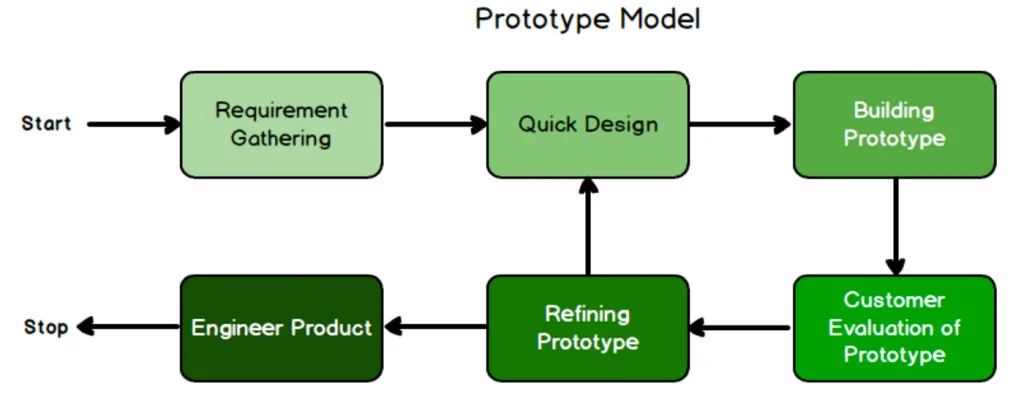
The Prototyping model is a software development approach designed to enhance the development team’s comprehension of the customer’s requirements and preferences by utilizing prototypes. This model involves the creation of working, small-scale versions of the desired software application, which serve as tangible representations of the final product. By engaging with these prototypes, stakeholders can visualize how the software will function, making it easier to convey their expectations and clarify any ambiguities.
One of the primary benefits of the Prototyping model is its ability to address miscommunications and misunderstandings early in the development cycle. As the prototypes are developed and presented, stakeholders have the opportunity to interact with them, providing feedback that can identify discrepancies between their initial requirements and the proposed solutions. This early engagement is crucial for ensuring that the final product aligns with user needs and mitigates the risk of costly revisions later in the project.
Additionally, the Prototyping model encourages a more iterative and user-centered approach to mobile app development. As prototypes evolve through multiple iterations, the development team can incorporate changes and refinements, resulting in a product that is more finely tuned to user expectations. This continuous feedback loop not only enhances the quality of the software but also builds a sense of ownership and satisfaction among stakeholders, as they see their ideas and concerns being integrated into the development process.
Advantages of Prototyping Model
- Prototypes serve as visual and functional representations of the software, facilitating clearer communication between developers and project stakeholders.
- By creating prototypes early in the development process, teams can better capture and refine user requirements.
- The Prototyping model encourages active participation from end-users throughout the product development cycle.
- By addressing misunderstandings and refining requirements through prototypes, teams can avoid extensive revisions during later stages of development.
- Prototypes can be tested and evaluated at various stages, allowing teams to identify and fix issues before the final product is developed.
Agile Model

The Agile software development model is an iterative and incremental approach that emphasizes flexibility, and customer-centricity throughout the process. Originating from the Agile Manifesto in 2001, this model prioritizes adaptive planning and encourages teams to respond to changing requirements, even late in the development cycle. Agile practices break projects into smaller, manageable units called iterations or sprints, which typically last from one to four weeks. This allows teams to deliver functional software more frequently without much errors.
One of the defining features of the Agile model is its focus on collaboration among cross-functional teams, including developers, designers, and stakeholders. Daily stand-up meetings, sprint planning, and retrospectives facilitate open communication, ensuring that all team members are aligned on project goals and progress. This collaborative environment not only enhances problem-solving capabilities but also empowers teams to make collective decisions, leading to a more efficient development process.
Moreover, Agile places a significant emphasis on customer involvement throughout the development lifecycle. By engaging customers regularly, teams can gather valuable feedback, ensuring that the final product meets user needs. This iterative approach allows for frequent adjustments based on real-world usage, reducing the risk of delivering a product that fails to resonate with users. Ultimately, Agile software development fosters a dynamic and responsive environment, enabling teams to produce high-quality software.
Advantages of Agile Model
- Agile development embraces change, allowing teams to respond quickly to evolving requirements and shifting priorities.
- By breaking projects into smaller, manageable iterations or sprints, Agile enables teams to deliver functional software more frequently.
- Agile emphasizes strong collaboration among cross-functional teams, including developers, designers, and stakeholders.
- The Agile model prioritizes customer involvement throughout the development cycle. By regularly engaging users, teams can ensure that the software aligns closely with user needs and expectations.
- Agile promotes continuous testing and integration throughout the development process, which helps identify and address issues early on.
Frequently Asked Questions
| Why understanding software development models is important for developers? Understanding software development models is crucial for developers as it provides a structured framework to guide their work. This knowledge helps them select the most suitable model for a given project, ultimately enhancing software quality. |
| What is agile software development methodology? Agile software development methodology is an iterative and incremental approach that emphasizes flexibility throughout the development process. It encourages teams to adapt to changing requirements quickly, delivering functional software in shorter cycles known as sprints. |
| What are the differences between Scrum and Kanban model? Scrum organizes work into fixed-length iterations called sprints, with defined roles and responsibilities. Kanban on the other hand, is a visual management method that focuses on continuous flow and flexibility. Essentially, Scrum emphasizes structured roles and time-boxed work, whereas Kanban prioritizes ongoing task visualization and flow optimization. |
Final Words
That takes us to the end of this blog in which we have discussed different software development models in detail. Being a developer, you should have a sound understanding of all the methodologies that are used in product development. From waterfall to iterative model, you should know how each methodology works in precise. This blog is precisely written to let you understand the differences and advantages of each software development model. It has defined the core functionality of each model, so that you can select the most suitable one for your product development.

Empower your digital journey with StruqtIO - Your dedicated partner for cutting-edge custom software development, innovation, and digital transformative solutions. Harness the power of technology to elevate your business and redefine your digital landscape today.
